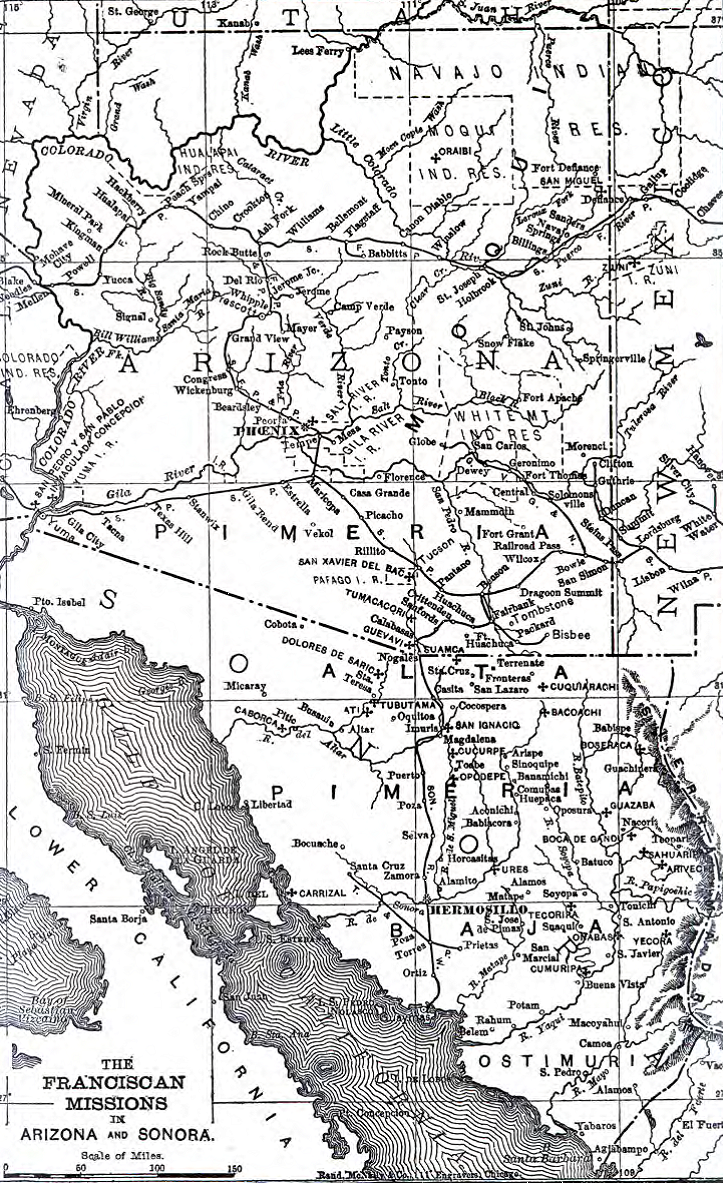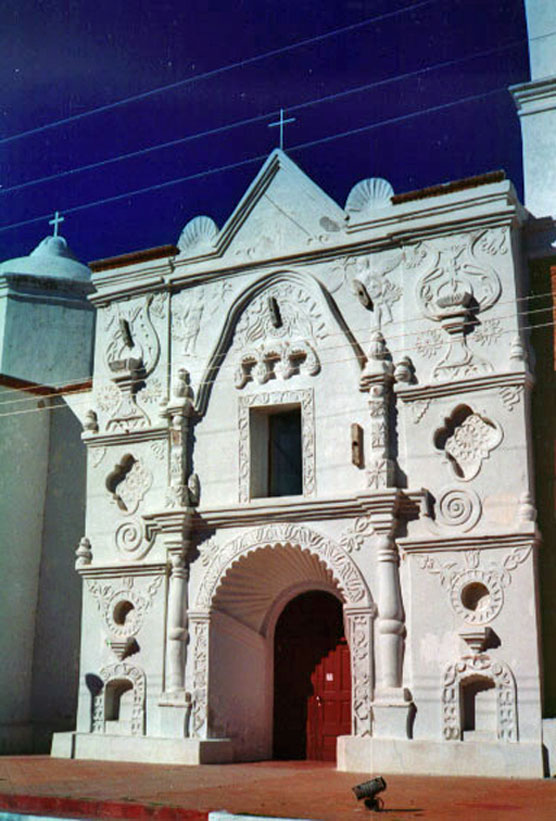|
Mission San Xavier Del Bac
Mission San Xavier del Bac () is a historic Spanish Catholic mission about south of downtown Tucson, Arizona, on the Tohono O'odham Nation San Xavier Indian Reservation. The mission was founded in 1692 by Eusebio Kino in the center of a centuries-old settlement of the Sobaipuri O'odham, a branch of the Akimel or River O'odham located along the banks of the Santa Cruz River. The mission was named for Francis Xavier, co-founder of the Jesuit Order in Europe. The original church was built to the north of the later Franciscan church and was demolished during an Apache raid in 1770. The mission was rebuilt between 1783 and 1797, which makes it the oldest European structure in Arizona. Labor was provided by the O'odham. An outstanding example of Spanish Colonial architecture in the United States, the Mission San Xavier del Bac hosts some 200,000 visitors each year. It is a well-known pilgrimage site, with thousands visiting each year on foot and on horseback, some among ceremonial ... [...More Info...] [...Related Items...] OR: [Wikipedia] [Google] [Baidu] |
Sonora
Sonora (), officially Estado Libre y Soberano de Sonora (), is one of the 31 states which, along with Mexico City, comprise the Administrative divisions of Mexico, Federal Entities of Mexico. The state is divided into Municipalities of Sonora, 72 municipalities; the capital (and largest) city of which is Hermosillo, located in the center of the state. Other large cities include Ciudad Obregón, Nogales, Sonora, Nogales (on the Mexico–United States border, Mexico-United States border), San Luis Río Colorado, and Navojoa. Sonora is bordered by the states of Chihuahua (state), Chihuahua to the east, Baja California to the west (of the north portion) and Sinaloa to the southeast. To the north, it shares a border with the United States, and on the southwest has a significant share of the coastline of the Gulf of California. Sonora's natural geography is divided into three parts: the Sierra Madre Occidental in the east of the state; plains and rolling hills in the center; and the co ... [...More Info...] [...Related Items...] OR: [Wikipedia] [Google] [Baidu] |
Presidio San Agustín Del Tucsón
Presidio San Agustín del Tucsón was a presidio (Spanish colonization of the Americas, colonial Spanish fort) located within Tucson, Arizona, Tucson, Arizona, United States. The original fortress was built by Spanish Empire, Spanish soldiers during the 18th century and was the founding structure of what became the city of Tucson. After the Mexican–American War, American arrival in 1846, the original walls were dismantled, with the last section torn down in 1918. A reconstruction of the northeast corner of the fort was completed in 2007 following an archaeological excavation that located the fort's northeast tower. History Spanish Period A company (military unit), company of Spanish Army soldiers, led by Captain (land), Captain Hugo Oconór, Hugh O'Conor, an Ireland, Irish mercenary working for Spain, selected the location of the Presidio San Agustin del Tucson on August 20, 1775. The site was on the east terrace overlooking the Santa Cruz River floodplain. Nearby was the O' ... [...More Info...] [...Related Items...] OR: [Wikipedia] [Google] [Baidu] |
Francisco Garcés
Francisco Hermenegildo Tomás Garcés (April 12, 1738 – July 18, 1781) was a Spanish Franciscan friar who served as a missionary and explorer in the colonial Viceroyalty of New Spain. He explored much of the southwestern region of North America, including present day Sonora and Baja California in Mexico, and the U.S. states of Arizona and California. He was killed along with his companion friars during an uprising by the Native American population, and they have been declared martyrs for the faith by the Catholic Church. The cause for his canonization was opened by the Church. History Garcés was born April 12, 1738, in Morata de Jalón, Aragon, north-central Spain. He entered the Franciscan Order about 1758 and was ordained a priest in 1763 in Spain.mojavedesert.net: Garcés . accessed 1.1.2012 New Spain |
Franciscan
The Franciscans are a group of related organizations in the Catholic Church, founded or inspired by the Italian saint Francis of Assisi. They include three independent Religious institute, religious orders for men (the Order of Friars Minor being the largest contemporary male order), an order for nuns known as the Order of Saint Clare, and the Third Order of Saint Francis, a Third Order of Saint Francis#Third Order Regular, religious and Secular Franciscan Order, secular group open to male and female members. Franciscans adhere to the teachings and spiritual disciplines of the founder and of his main associates and followers, such as Clare of Assisi, Anthony of Padua, and Elizabeth of Hungary. Several smaller Franciscan spirituality in Protestantism, Protestant Franciscan orders have been established since the late 19th century as well, particularly in the Lutheranism, Lutheran and Anglicanism, Anglican traditions. Certain Franciscan communities are ecumenism, ecumenical in nat ... [...More Info...] [...Related Items...] OR: [Wikipedia] [Google] [Baidu] |
Charles III Of Spain
Charles III (; 20 January 1716 – 14 December 1788) was King of Spain in the years 1759 to 1788. He was also Duke of Parma and Piacenza, as Charles I (1731–1735); King of Naples, as Charles VII; and King of Sicily, as Charles III (or V) (1735–1759). He was the fourth son of Philip V of Spain and the eldest son of Philip's second wife, Elisabeth Farnese. He was a proponent of enlightened absolutism and regalism. In 1731, the 15-year-old Charles became Duke of Parma and Piacenza following the death of his childless grand-uncle Antonio Farnese, Duke of Parma, Antonio Farnese. In 1734, at the age of 18, he led Spanish troops in a bold and almost entirely bloodless march down Italy to seize the Kingdom of Naples and Kingdom of Sicily and enforce the Spanish claim to their thrones. In 1738, he married the Princess Maria Amalia of Saxony, daughter of Augustus III of Poland, who was an educated, cultured woman. The couple had 13 children, eight of whom reached adulthood. They resided ... [...More Info...] [...Related Items...] OR: [Wikipedia] [Google] [Baidu] |
Alonso Ignacio Benito Espinosa
Alonso Ignacio Benito Espinosa (1720–1786) was a Spanish Jesuit List of missionaries to New Spain, missionary to New Spain. Biography Espinosa was born on February 1, 1720, in Las Palmas, Gran Canaria. He was ordained at age twenty-one in Mérida, Yucatán, and subsequently moved to Michoacán. After recovering from a serious illness during a visit to Guanajuato, Espinosa entered the Society of Jesus on August 14, 1750. He completed his novitiate on August 15, 1752, and was assigned to the Spanish missions in the Sonoran Desert. In May 1754, Espinosa was assigned to Mission La Purísima Concepción de Nuestra Señora de Caborca. He traveled there together with Governor and Father Visitor Carlos de Roxas, but returned to San Ignacio due both to his poor health and to unrest among the Caborca natives. In June, the provincial superior, Joseph de Utrera, reassigned Espinosa to Mission San Xavier del Bac. The residence there was not yet complete, so Espinosa relocated temporarily ... [...More Info...] [...Related Items...] OR: [Wikipedia] [Google] [Baidu] |
Apache
The Apache ( ) are several Southern Athabaskan language-speaking peoples of the Southwestern United States, Southwest, the Southern Plains and Northern Mexico. They are linguistically related to the Navajo. They migrated from the Athabascan homelands in the north into the Southwest between 1000 and 1500 CE. Apache bands include the Chiricahua, Jicarilla Apache, Jicarilla, Lipan Apache people, Lipan, Mescalero, Mimbreño Apache, Mimbreño, Salinero Apaches, Salinero, Plains Apache, Plains, and Western Apache (San Carlos Apache Indian Reservation, Aravaipa, Pinaleño Mountains, Pinaleño, Fort Apache Indian Reservation, Coyotero, and Tonto Apache, Tonto). Today, Apache tribes and Indian reservation, reservations are headquartered in Arizona, New Mexico, Texas, and Oklahoma, while in Mexico the Apache are settled in Sonora, Chihuahua, Coahuila and areas of Tamaulipas. Each Native American tribe, tribe is politically autonomous. Historically, the Apache homelands have consisted of ... [...More Info...] [...Related Items...] OR: [Wikipedia] [Google] [Baidu] |
New Spain
New Spain, officially the Viceroyalty of New Spain ( ; Nahuatl: ''Yankwik Kaxtillan Birreiyotl''), originally the Kingdom of New Spain, was an integral territorial entity of the Spanish Empire, established by Habsburg Spain. It was one of several domains established during the Spanish colonization of the Americas, Spanish conquest of the Americas, and had its capital in Mexico City. Its jurisdiction comprised a large area of the southern and western portions of North America, mainly what became Mexico and the Southwestern United States, but also California, Florida and Louisiana (New Spain), Louisiana; Central America as Mexico, the Caribbean like Hispaniola and Martinique, Martinica, and northern parts of South America, even Colombia; several Pacific archipelagos, including the Philippines and Guam. Additional Asian colonies included "Spanish Formosa", on the island of Taiwan. After the 1521 Spanish conquest of the Aztec Empire, conqueror Hernán Cortés named the territory New S ... [...More Info...] [...Related Items...] OR: [Wikipedia] [Google] [Baidu] |
Pimería Alta
The ''Pimería Alta'' (translated to 'Upper Pima Land'/'Land of the Upper Pima' in English) was an area of the 18th century Sonora y Sinaloa, Sonora y Sinaloa Province in the Viceroyalty of New Spain, that encompassed parts of what are today southern Arizona in the United States and northern Sonora in Mexico. The area took its name from the Pima people, Pima and closely related O'odham (''Papago'') peoples residing in the Sonoran Desert. Pimería Alta was the site of the Spanish missions in the Sonoran Desert established by the Jesuit missionary Eusebio Kino in the late 17th and early 18th centuries. A significant Pima Indian Revolt, Pima rebellion against Spanish rule occurred in 1751. Terminology The term Pimería Alta first appeared in Spanish colonial documents (especially produced by those in the History of the Catholic Church in Mexico, Catholic Church) to designate an ethno-territorial expanse that spanned much of what is now southern Arizona and northern Sonora. The term ... [...More Info...] [...Related Items...] OR: [Wikipedia] [Google] [Baidu] |
Spanish Missions In The Sonoran Desert
The Spanish missions in the Sonoran Desert () are a series of Jesuit Catholic religious outposts established by the Spain, Spanish Roman Catholic, Catholic Society of Jesus, Jesuits and other orders for religious conversions of the Pima people, Pima and Tohono O'odham Indigenous peoples of the Americas, indigenous peoples residing in the Sonoran Desert. An added goal was giving Spain a Spanish colonization of the Americas, colonial presence in their frontier territory of the Sonora y Sinaloa, Sonora y Sinaloa Province in the Viceroyalty of New Spain, and relocating by Indian Reductions (''Reducciones de Indios'') settlements and encomiendas for agricultural, ranching, and mining labor. Geography and history The missions are in an area of the Sonoran Desert, then called "Pimería Alta de Sonora y Sinaloa" (Upper Pima of Sonora and Sinaloa), now divided between the Mexican state of Sonora and the U.S. state of Arizona. Jesuits in missions in Northwestern Mexico wrote reports that ... [...More Info...] [...Related Items...] OR: [Wikipedia] [Google] [Baidu] |







